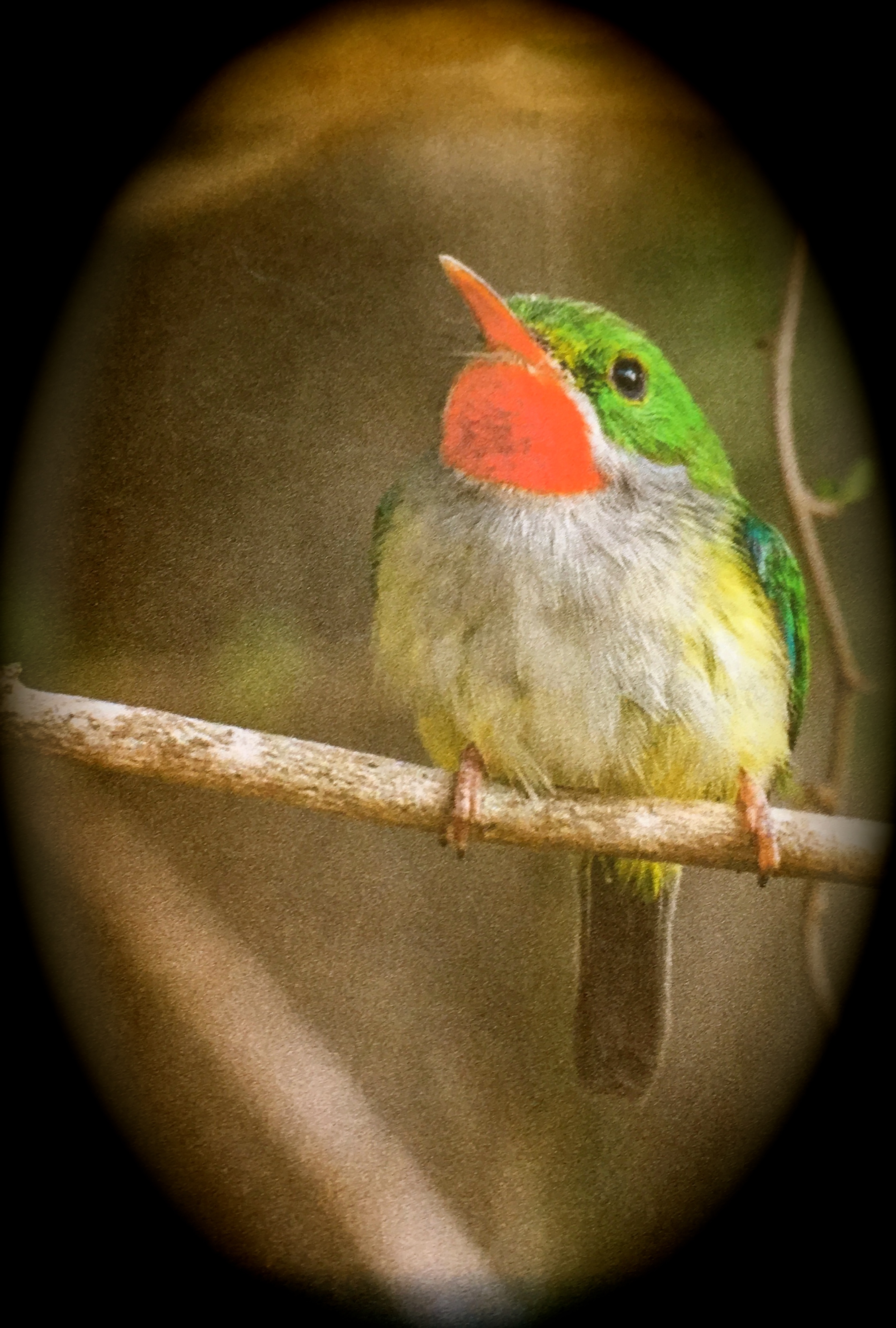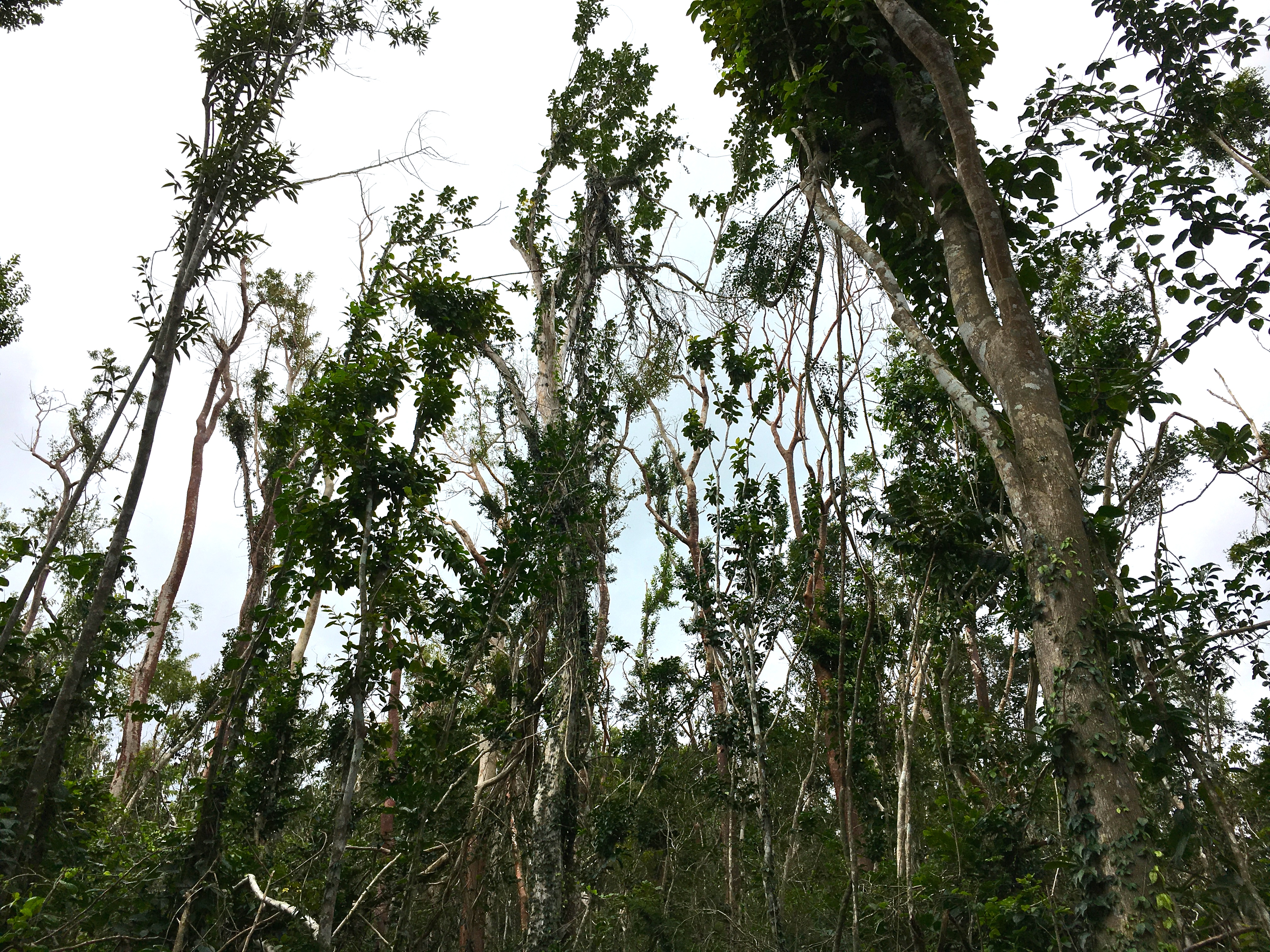
There are only five species of todies in the world. Two live in Hispaniola, the island shared by the Dominican Republic and Haiti, and one each in Cuba, Jamaica and Puerto Rico. I have seen THREE of them. What a kick! And now, I have met the man whose life mission is to make the Puerto Rican tody the symbol of Puerto Rico.
Todies are small, jewel-like birds, the size of a hummingbird. Their vivid emerald-green back and head are contrasted with a nail-polish-red throat patch. The red throat is accented by the thin border of white around it and by the tody’s characteristic upward head tilt. The five species show subtle differences in the coloration of the breast, some variation in the width of the bill, and one has a spot of blue on the head. They are short distance flyers and so live only on their particular island.

My first tody sighting was in Jamaica in the 1990s. At the time, I didn’t even know there was such a bird as a tody. I thought the name unattractive, too much like “toady,” but the bird was beautiful. It looked like someone wearing a green coat with a red ascot. Bill and I saw the Cuban tody in 2013. It sat quietly on a low branch in the forest at Las Terrazas Reserve. The tody was the mascot for the place.

I saw the Puerto Rican tody in February, 2018. It was almost five months after Hurricane Maria. Recovery of both natural and manmade structures was spotty. Tree leaves had grown back, but in disorganized clumps like hair sprouting from old men’s ears. Many utility poles were still down. Street signs stood at skewed angles.
It’s a wonder that the birds weren’t all swept out to sea. Our birding guide, Gabriel Lugo, told Bill and me that more birds died from starvation than from the actual storm as every tree was stripped bare and there was no food. Gabriel drove us from San Juan in the northeast of the island over the mountains all the way to the southwestern tip. We saw several todies in the dry forest (versus the rain forest).
The next day was rainy. Gabriel took us to a friend’s house that had hummingbird feeders. This was in a mountainous section that was hit especially hard by Maria. We drove through rugged terrain, passing newly repaired bridges and roofs covered with disaster-blue tarps.
Pepe, a sturdily built man with an easy grin, met us at the top of his steep driveway. I couldn’t gauge Pepe’s age: older than Gabriel, younger than us. Of course, that’s anywhere from 35 to 70. He escorted us to a covered porch fronted by a decorative metal grille. Outside of the bars was a colorful garden studded with a half dozen hummingbird feeders on poles. Scores of hummers –green mangos, Puerto Rican emeralds and Antillean mangos — chased each other from feeder to feeder to nearby bushes with ferocious intensity.
Gabriel mentioned that Pepe’s carefully selected plantings were torn up by the hurricane. Pepe said that during the storm, he and his wife anchored the feeders to the grille inside of the porch to lure the hummers to protection. I asked Pepe how he was coping with the aftermath. He was not at all emotional. He said, “One minute something is there. The next, it’s not.”

I can’t remember who first mentioned the tody, but it soon became clear that Pepe was an expert. He and his wife, Fela, travel extensively in Latin America making nature videos. They have a portmanteau professional name: FelPe. And he has a passion: to change the scientific name of the Puerto Rican tody, affectionately called “San Pedrito” or Little Saint Peter, from todus mexicanus to todus portoricensis. (Todus is Latin for “something small.”)
He presented me with his book, The Root of the Antilles: the History of the Todidae Family, which presses his case to the International Commission for Zoological Nomenclature (ICZN). The book begins with European sightings of the tody, the first one in 1687 by a Dutchman in Jamaica. In the following centuries, French, English and Dutch saw different species of the tody (on their respective islands) and tried to describe, draw and classify them.

In 1837, an Englishman, John Gould, and his wife, Elizabeth, made accurate drawings of the Cuban tody and called it todus multicolor. Unfortunately, they neglected to present their findings to the correct zoological society, so that the findings went uncredited.
The very next year, 1838, Adolphe Lesson, a doctor in the French navy, sent his brother Rene in France a description matching that of the Cuban tody. He claimed he shot it in Porto Rico. (The name Porto Rico was changed to Puerto Rico in 1932.) Rene Lesson called the Cuban tody todus portoricensis, named after Puerto Rico. Adolphe also described another tody he claimed he captured in Tampico, Mexico. Rene called this bird todus mexicanus, named after Mexico. That bird was the Puerto Rican tody. As Pepe states in the book, “At that moment our species were tied together and we have yet been unable to untie the knot.” (There aren’t and never were todies in Mexico.)
In the ways of the Nomenclature Commission, chronological precedence is very important. So, even though it seems obvious that the Puerto Rico tody should be called puertoricensis or portoricensis, this has not happened. It appears that the Cuban tody managed to escape the fate of being the “todus portoricensis,” to become the appropriately named todus multicolor because of the 1837 Gould findings.
This book shows how messy science can be. Mistakes, confusion and very bad illustrations (no photos in those days) abound, and these untruths are often copied and passed on. Pepe and Fela ((Jose Gonzalez Diaz and Felisa Collazo Torres) wrote in the book their official petition to the ICZN to change the name for scientific accuracy and to honor Rene Lesson’s intent to associate the bird with its proper location. They seek taxonomic justice.
At the time Pepe gave me the book, I was astounded and moved by the effort he and his wife had put into teasing out the history and the science of this little bird. I was impressed by how passionately they advocated for the name change. But I was also a bit puzzled. Here was a man who dismissed the destruction of his garden, being cut off from the village by the washed out bridge and living without electricity for months with a philosophical shrug. And yet, he has written an entire book because of the Latin name of a bird.
When I read the book, however, I was persuaded by Pepe’s reasoning. He wants the San Pedrito to be the emblematic bird of Puerto Rico. He wants it to be a unifying force for the community, a point of pride. He wants this pride to transfer to protection of the habitat of the bird in particular and of the environment of Puerto Rico in general. He wrote, “The apparent simple act of rectification [of the name] allows us to understand the enormous benefits that gives us the fragile and complex stability that is ultimately what assures us our survival.” I’d fight that hard for survival too.

Long live todus portoricensis!
Tell me: Do you have a passion that others may consider quixotic? What is it?
4 replies on “Taxonomic Justice for Puerto Rican Todies”
Beautiful story, beautiful bird. Medicine was my passion. Now I seek to expand my horizons. No regrets, just enjoying today and moving forward.
Jane
LikeLike
I wish I had a passion, quixotic or not! Life would be so satisfying if I had an obsessive interest to pursue, the way a golden retriever finds pure bliss in chasing tennis balls … for hours and hours. A close friend of mine is an obsessive writer. She’s written more than thirty (30!!) novels (and published most of them) by writing on nights and weekends. She says that she MUST write. On days that she doesn’t write, “it feels like insects are crawling on my arms.” Now that’s passion. I don’t even feel that committed to brushing my teeth.
LikeLiked by 1 person
Re Quixotic passion: I suppose my participation in the little-known sport (in the USA) of Olympic weightlifting, over a 50-year period, could be considered odd. My first contest was at age 18, as a college freshman, and my last at age 67, in the ‘Masters’ division. I’d be doing it still if arthritis and other neuromuscular issues hadn’t put an end to it. As it is, I still regularly drag myself to the Y and haul on the weight machines.
LikeLiked by 2 people
How long does it take for this association to make a decision and are they likely to decide in favor? Unfortunately no such passion guides my life but I love how saving this little bird saves PR…
LikeLike